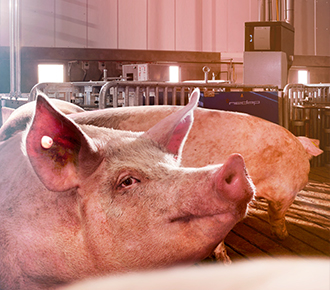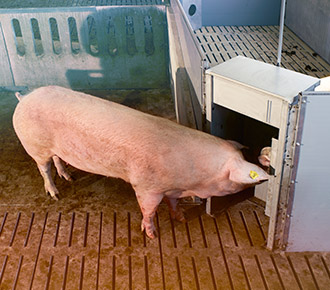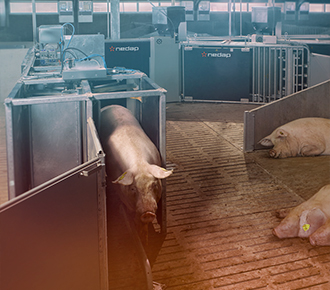“The Nedap sow management system is helping me stay in business and be competitive even with my small operation.”
Who?
Mel Gerber
Mel Gerber - farm owner
Where?
Versailles, Missouri, USA
About the farm
- 200 sows
- 2 Nedap Electronic Sow Feeders
- Remodeled sow barn built in 1996
Nedap solutions
Results
A barn to fit your management style
Sow barn remodel gives farm new future
Missouri farmer Mel Gerber chose Nedap Livestock Management as his sow barn remodeling partner. As a result, he finally has the sow management system he wished he’d had when he built the barn in 1996.
With the help of Nedap’s design and support teams, Gerber replaced his individual gestation stalls with a group sow gestation pen. Gerber’s sows are calm and comfortable, and he is caring for them the way he wants.
“The Nedap sow management system is helping me stay in business and be competitive even with my small operation,” says Gerber. “We turned an old barn into a barn we like, and I can keep caring for my sows the way I think is right.”
Remodeling the barn required minimal pouring and zero tearing out of concrete. Gerber’s 40- by 80-square-foot barn was originally built with two central rows of slats and individual gestation stalls. The group pen was designed to accommodate sow dunging patterns and resting areas over the existing floor slats.
“Since installing the Nedap equipment, I enjoy raising sows much more. It makes busy work much easier.”
About 120 gestating sows live in one large pen with two Nedap Electronic Sow Feeders, as well as Nedap Automatic Sow Separation and Automated Heat Detection. The existing gutter flush system works in the group pen as well as it did when the sows were in stalls. Gerber farrows sows in a previously renovated finisher barn.
Better observation for better sow management
Gerber thinks a primary benefit of his new is system the ability to observe his sows. He can watch their behavior, and the Nedap Electronic Sow Feeding system sends him automatic notifications if a sow isn’t eating or is coming into heat.
“I can observe my sows at a higher level than I was doing in the gestation stalls,” Gerber says. “In stalls, the animals don’t move around. They don’t socialize or demonstrate their behavior, so it’s hard to tell when something is wrong.”
As Gerber’s sows transitioned into the new space, their behavior dramatically changed.
“In a stall, if I walked up and put my hand in, the sow would have backed away. That doesn’t happen anymore,” says Gerber. “They’re so gentle. With my Nedap Electronic Sow Feeding system, it is possible to handle sows right in the pen.”
The Nedap Electronic Sow Feeding system is precise and easy to use
Nedap Electronic Sow Feeding systems are designed to minimize feed waste, and Gerber has noticed the difference.
“The Nedap Electronic Sow Feeding system is precise,” says Gerber. “Instead of eyeballing feed weights, we are feeding accurate amounts to individual sows. We’re grinding feed less often, and we think we’ve reduced feed waste by about 15 percent.”
The Nedap system saves Gerber time, too. For example, when he wants to pull sows from the group to move to farrowing, the system identifies the sows based on data he enters. The sow separation unit identifies and moves the sows that need Gerber’s attention into a holding pen where he can easily find them.
Gerber isn’t the only one who thinks the Nedap system is easy to use. His sows do, too. Gerber populated his new pen with the same herd he previously housed in stalls. The sows quickly learned how to use the automated feeders and share living space peacefully.
Designed with the sow in mind
Nedap group sow gestation pens put sow comfort first
Gerber thinks the group sow gestation pen with Nedap ESF is better for his sows’ well-being than other systems. He has observed improved air movement in the pen and noticed his sows didn’t even need the new fogger system he installed to help them stay cool in the summer.
“As a stockman, you want to care for animals in a way that makes them the most comfortable,” Gerber says. “In this system, the animals like the environment they’re in, and they have control over where they move or when they eat.
“When the remodel was done, I was much more satisfied with my sows’ comfort. They just stay comfortable.”

What's working on other farms?
How would automated individual sow feeding in group housing change your business?
Search results for: ''
There are no results matching your criteria. Please try again with different criteria.


